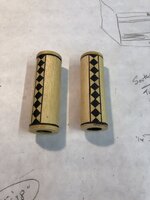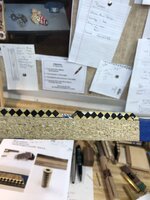jimmyz
Member
Haven't made many pens lately but wanted to try a few new segmented designs. I know it can be a challenge to keep the blanks from coming apart, but my experience over the last two days is ridiculous! Main problem seems to occur when I approach the right end of the blank, with the tool moving left to right.
I would appreciate any ideas or tricks you use when working with segmented pen blanks. I know about sharp tools, light cuts, and lots of CA. Thanks for the help.
I would appreciate any ideas or tricks you use when working with segmented pen blanks. I know about sharp tools, light cuts, and lots of CA. Thanks for the help.


